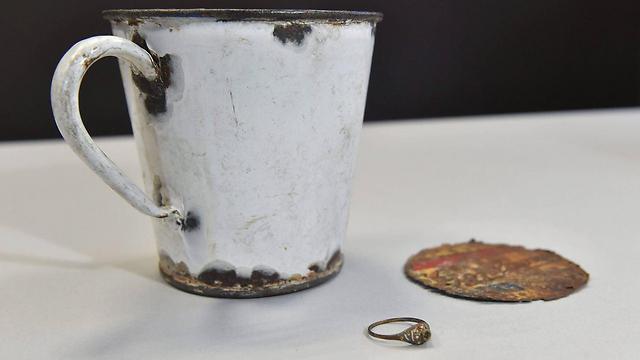
The Auschwitz Museum staff has found a mug with a double bottom and jewelry hidden inside in one of dozens of thousands of enameled kitchenware looted by the Germans from people deported to Auschwitz-Birkenau.
‘During the works to secure the enameled kitchenware located at the main exhibition, it turned out that one of the mugs has a double bottom. It was very well hidden, however, due to the passage of time, the materials underwent gradual degradation, and the second bottom separated from the mug,’ said Hanna Kubik of the Memorial Collections.
‘Under it, among others was a women’s ring made of gold and a necklace wrapped in a piece of canvas. The ring as well as the chain have test properties for gold 583 placed on products produced in Poland in the years 1921-1931. It is the head of a knight with the number three on the right side. For detailed confirmation of the contents of the findings, the object was subjected to specialist tests, among others x-ray pictures, and a test using the XRF method, which proved the presence of the metals: copper, gold and silver’ – added Kubik.
Despite the passage of more than 70 years since the liberation of the German Nazi concentration and extermination camp, there are still cases of accidental discovery of objects hidden by the victims. ‘The Germans incessantly lied to the Jews deported for extermination. They were told about resettlement, work and life in a different location. They allowed the victims take with them little luggage. In this way, the Germans were confident that in the luggage – including clothes and items needed for life – they would find the last valuables of the deported families,’ said the Director of the Auschwitz-Birkenau State Museum Dr. Piotr M. A. Cywiński.
‘The hiding of valuable items – repeatedly mentioned in the accounts of survivors, and which was the reason for ripping and careful search of clothes and suitcases in the warehouse for looted items – so-called “Kanada” – proves on the one hand to the awareness of the victims as to the robbery nature of the deportation, but on the other hand it shows that the Jewish families constantly had a ray of hope that these items will be required for their existence’ stressed director Cywiński.
All findings are carefully documented and secured by the conservators, because they are the most recent traces of individual victims of the camp. Unfortunately, quite often the owners of these items remain anonymous, because there are no traces left on the objects to help identify them.
In the Collections of the Memorial, there are more than 12,000-enameled kitchenware, among others, cups, pots, bowls, kettles, jugs, including crockery decorated with images of children playing and images of animals.
The jewelry found in the mug will be stored in the Collections of the Museum in the form reflecting the manner in which it had been hidden by the owner, as a testimony to the fate of the Jews deported to the German Nazi concentration and extermination camp.
{Matzav.com}











